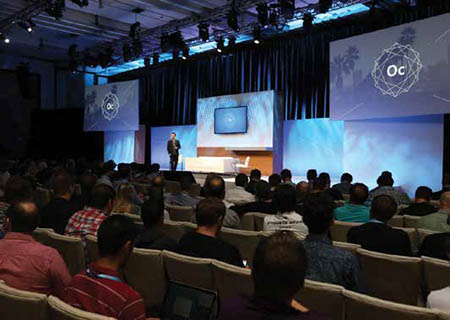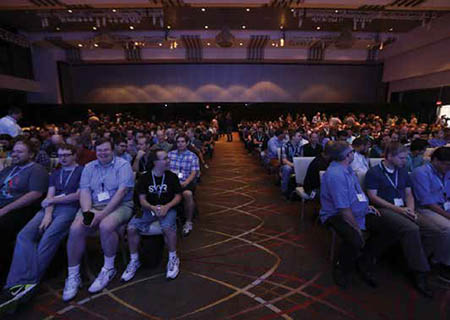Drama-Free Digital: FNtech Upgrades

On September 20, 2014, virtual reality headset-maker Oculus hosted 1,000 delegates at “Oculus Connect” in Hollywood, CA, the company’s first developer conference. FNtech, the Fountain Valley, VA, technical services company that produces Oculus’ Facebook video channel, experienced its own first at this event: It was the first time that FNtech used a digital intercom system to cover a live production.
“We were accustomed to using a Clear-Com analog partyline system,” said FNtech CEO Jeremy Muir. “However, the fact that we had migrated our audio production system to digital—including repelling our connective cabling ‘snake’ with fiber in place of copper—meant that it was time to bring our intercoms into the digital 21st century.”
To make this leap, FNtech again went with Clear-Com. Specifically, the company purchased two Clear-Com HMS-4X HelixNet Main Stations, plus 20 2-Channel HelixNet beltpacks. FNtech also acquired two Tempest wireless base stations, each of which came with five Tempest wireless beltpacks. Each HelixNet Main Station was connected to a Tempest base station, with the two HelixNets being linked to each other by fiber optic cable.

Two Clear-Com HMS-4X HelixNet Main Stations & 20 two-Channel HelixNet beltpacks helped the team’s digital transition. “We were doing a standard three-camera shoot in the Ray Dolby Ballroom inside the Loews Hollywood Hotel,” said Muir. “We were streaming live to the Internet, hitting 10,000 viewers at the peak, covering the various presentations as they took place on stage. For audio, we had a Front of House (FOH) main audio console, where one of the HelixNets was based. The other was located backstage. Linking them was the same single fiber optic cable that was also carrying all of the show’s audio signals back to the board: We didn’t have to lay any extra cables for the intercoms!”
The HelixNet’s wired beltpacks were used by FNtech staff working in fixed positions, such as the FOH/backstage audio boards and the camera positions. The Tempest wireless beltpacks were worn by roving crew members, so that they could stay on the move without ever losing connectivity.

FNtech’s worries about moving from tried-andtrue analog to unknown digital intercoms were dispelled once the HelixNets were plugged into the fiber optic backbone. “As soon as the units came online, they were available over our IP network,” Muir said. “There was absolutely no hassle or setup issues at all: You plugged them in, and they worked, no problems.”
The same was true for the Tempest wireless systems. FNtech discovered that the wireless and wired intercom systems meshed seamlessly, and that connectivity was achieved as soon as a beltpack was switched on. “What was also nice, being digital, is that we no longer had hum and buzzing and all the other sound degradations that go with analog, and which one takes for granted,” said Muir. “The sound was full-spectrum, clear, and clean; no matter where the person using the Tempest beltpack happened to be in the ballroom.”
A daily selection of features, industry news, and analysis for tech managers. Sign up below.

An added bonus: FNtech was able to set up eight individual audio networks over the HelixNet Main Station system, allowing the staff to designate specific networks for audio, camera, stage crew, and others. “We also had a common channel, over which the head person could talk to everyone on the Clear-Com system at the same time,” Muir said. “This meant that people who didn’t need to hear the cameramen talking to the video switcher didn’t have to—and if we needed to alert everyone at once, we could do so at the push of a button.”
FNtech’s experience with moving to an all-digital intercom system—one that meshes nicely with their all-digital audio production backbone—proved to be a very positive experience. In fact, making the switch while covering Oculus Connect proved to be painless, while the enhanced audio performance, flexibility, and coverage provided by the HelixNet/Tempest combination actually made production go smoother than before.
“I just wish that all technology upgrades were as easy to execute and rewarding to use as going from Clear-Com analog to digital intercoms,” concluded Jeremy Muir. “If we had known that making the move would turn out this well, we would have done it years ago.”
James Careless is a regular contributor to NewBay Media’s AV Technology magazine.
James Careless is an award-winning freelance journalist with extensive experience in audio-visual equipment, AV system design, and AV integration. His credits include numerous articles for Systems Contractor News, AV Technology, Radio World, and TV Tech, among others. Careless comes from a broadcasting background, with credits at CBC Radio, NPR, and NBC News. He currently co-produces/co-hosts the CDR Radio podcast, which covers the Canadian defense industry. Careless is a two-time winner of the PBI Media Award for Excellence.

